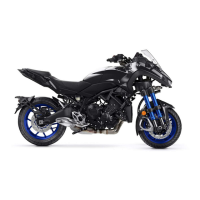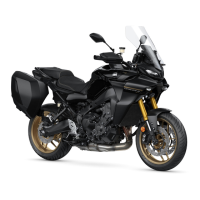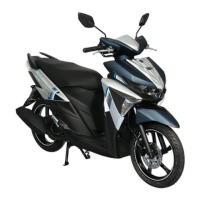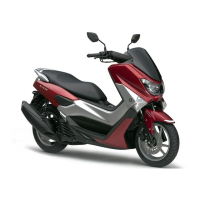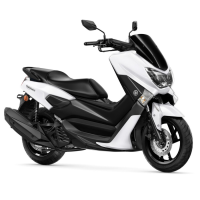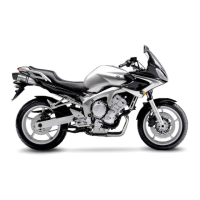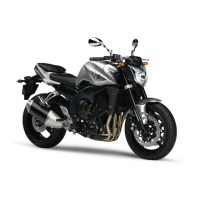Do you have a question about the Yamaha NIKEN GT 2020 and is the answer not in the manual?
Explains safety alert symbols, WARNING, NOTICE, and TIP notations used in the manual.
Owner's responsibilities, safe riding tips, pre-operation checks, and general riding safety.
Guidelines on wearing helmets, face shields, jackets, boots, and gloves for rider protection.
Hazards of carbon monoxide poisoning and safe practices for loading cargo onto the vehicle.
Advice on using genuine Yamaha accessories and potential risks of aftermarket parts.
Guidelines for aftermarket tires and safe procedures for transporting the motorcycle.
Identifies key components on the left side of the motorcycle with references.
Identifies key components on the right side of the motorcycle with references.
Identifies handlebar controls, levers, and instrument panel features.
Explains the immobilizer system, key usage, and precautions to prevent theft.
Details the functions of the main switch and how to lock the steering.
Describes the operation of switches on both left and right handlebars.
Explains the meaning and function of various indicator and warning lights on the instrument panel.
Details TCS, shift, immobilizer indicators and transponder interference.
Guide to activating, setting, adjusting, and deactivating the cruise control system.
Explains the various displays and settings available on the multi-function meter unit.
Describes the D-mode electronic engine performance system and its modes.
Explains the clutch-less upshift system and its operation.
Details the front and rear brake levers, pedal, and the Anti-lock Brake System (ABS).
Explains the traction control system, its settings, engagement, and warnings.
Instructions for opening, closing, and warnings related to the fuel tank cap and fuel system.
Procedures for removing/installing seats and using the storage compartment.
Guidance on adjusting front fork damping and spring preload for optimal performance.
Information on using power outlets and the operation of the sidestand and its safety switch.
Explains the system that prevents starting or stops the engine under specific conditions.
Procedures for checking fuel level, lines, overflow hose, and engine oil level.
Steps to check coolant level, system for leaks, and front brake operation and fluid.
Checks for rear brake, clutch operation, free play, and throttle grip smoothness.
Inspection of drive chain, wheels, tires, and brake/shift pedals for proper condition.
Checks for brake/clutch levers, centerstand/sidestand pivots, and chassis fasteners.
Verifying the operation of instruments, lights, signals, switches, and the sidestand switch system.
Guidelines for breaking in the engine to ensure longevity and performance.
Steps and conditions for safely starting the engine, including system checks.
Explains gear shifting, clutch operation, and procedures for accelerating and decelerating.
Tips for reducing fuel consumption and proper procedures for parking the vehicle.
Details the contents of the tool kit and advice on its usage for maintenance.
Charts outlining maintenance intervals for emission control systems based on mileage.
Comprehensive charts for general maintenance, lubrication, and replacement schedules.
Instructions for removing and reinstalling body panels for maintenance access.
Guidance on inspecting, cleaning, gapping, and tightening spark plugs.
Procedures for checking engine oil level and changing oil and oil filter cartridge.
Instructions for checking coolant level and periodic coolant changes.
Procedures for replacing the air filter element and checking engine idling speed.
Checks for throttle grip free play, valve clearance, and tire pressure and condition.
Information on cast wheels and adjusting the clutch lever free play.
Checks for brake lever free play, brake light switches, and brake pad wear.
Procedures for checking brake fluid level, changing fluid, and adjusting drive chain slack.
Guidance on cleaning and lubricating the drive chain, and checking control cables.
Procedures for lubricating and checking brake/clutch levers, pedals, centerstand, and sidestand.
Battery care, charging, storage, and procedures for replacing fuses.
Guides for diagnosing and resolving common engine and system problems.
Steps for diagnosing and addressing engine overheating issues, including coolant checks.
Specific advice on cleaning and maintaining matte colored parts without damage.
Detailed instructions for washing, rinsing, and drying the motorcycle to prevent damage.
Recommendations for storing the vehicle in cool, dry conditions and long-term storage preparation.
Key physical dimensions, weight, and engine specifications of the motorcycle.
Details on recommended fuel, tire sizes, and brake system types.
Information on the electrical system voltage, battery model, and bulb wattages.
Location and importance of vehicle identification and engine serial numbers for registration and parts.
Information on the diagnostic connector, vehicle data storage, and privacy policy.
| Displacement | 847 cc |
|---|---|
| Bore x Stroke | 78.0 mm x 59.1 mm |
| Compression Ratio | 11.5:1 |
| Fuel Delivery | Fuel injection |
| Transmission | 6-speed |
| Rear Brakes | 282 mm hydraulic disc |
| ABS | Yes |
| Traction Control | Yes |
| Tires Front | 120/70 R15 |
| Tires Rear | 190/55 R17 |
| Engine Type | Liquid-cooled, DOHC, inline 3-cylinder |
| Power | 115 hp @ 10, 000 rpm |
| Torque | 87.5 Nm @ 8, 500 rpm |
| Rear Suspension | Monoshock |
| Front Brakes | Dual 298 mm hydraulic disc |
| Seat Height | 825 mm |
| Fuel Capacity | 18 liters |
| Weight | 580 lbs (263 kg) |

